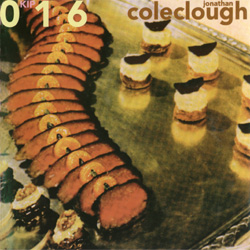
Windlass
Jonathan Coleclough
Tracklist
1. Windlass (41.06)

Coleclough holding windlass (photo by Lesley Doyle)
From the sleevenotes:
I first met Jonathan Coleclough at one of Lady Blacksell’s impromptu but lighthearted garden parties. He cowered on the lawn and spoke about films. He went on to study Snipe in ditches with me for many a year and moved easily in the most fashionable salons before his sudden relocation to the Free State of Eldonia. There he shuns polite society and builds some sort of machinery, I forget what, whilst issuing to the world increasingly peremptory and imperious manifestos at which the world, of course, merely snuffles. He refused to see me upon my last visit, but I will always respect him for his sybaritic swish. He has few friends, no hobbies, and moves with the grace of a sloth.
Don Coyote
Reviews
Windlass is the finest ambient I’ve heard in ages. A low, quiet drone sets the tone and is joined by a higher, more distant one. Extremely subtle shifts in texture occur - now the drone seems to be generated by a pipe organ, and the accompanying static hiss soon metamorphoses into field recordings of chirping birds. Things get even quieter about one-third of the way through; bass notes thrum sparsely over one, thin, high-pitched note that borders on the inaudible, eventually becoming a thready buzz recalling a nighttime cricket chorus. The low drone returns for the final third of the piece before higher pitches overcome it and carry the sounds off into oblivion and the conclusion of this forty-minute masterpiece. Jonathan Coleclough somehow achieves comforting warmth and chilling abandonment in concert with one another, transporting the listener to a region of utter ambiguity. With Windlass, he has produced a timeless work of art. Utterly perfect.
Stephen Fruitman, Ambientrance, Sweden, Dec 1999.
Volume is the key to the mood created by listening to this record - at low level it’s a background chill-out for more contemplative moments - at higher margins, the boom and drone becomes all-encompassing, even threatening, and not just to glasses or the position of small objects in the vicinity of the speakers...
Antron S. Meister, Freq, 2000.
The sorrowful and slothful music of ‘Windlass’ flows and hovers in the air in order to fall into the abysses and then to rise again at its end, representing the perfect communion between Terry Riley and Robert Hampson. A beauty so rare which pardons the lie hidden in the title: more than from a windlass this music seems being generated by an organ!
Blow Up magazine, Italy, 2000 (translated from Italian by Emiliano Gatto.)
A delerious delicasy of dark sound and wistful dalliance. Rather like walking through the park on the rainiest day all year, those inclined to enjoy inclement weather will adore this recording. I’ve never heard dark ambience sound so positively wet and bright and alive. Truly, a wonder to be heard.
Kirin, Starvox, Feb 2000.
It’s probably irrelavant that the source material for ‘Windlass’ is a slow moving crank which controls water flow on a dam, as Coleclough’s metamorphosis of the original sound results in a deep sturnum rumbling bass drone paired with field recordings of distant twittering birds (a la Messaien). Swells of slowly churning resonance may be the only sonic reference to the metallic cycling of the source material. Highly recommended!
Aquarius Records, 2000.
Long tones and ambient sounds are layered to create a soundscape of dreamy, but strong beauty. The dynamics are amazing and so are some of the sound recordings. Everything fits very tightly together, creating a relaxed tension, that never fails to attract (my) attention. What more can I say? It’s a beautiful record!
Meelkop Roel, Vital Weekly 195, Oct 1999.
The most appropiate word might be ‘dark ambient’, but it dosen’t fall in the same trap as much of the highly synthetic ambient that flooded the market some years ago. Coleclough produces his own disntinctive sound.
www.riouxs.com, 2000.
... effervescence tinged with faint digital grit ... Intriguingly abstract...
Ambientrance, Jan 2000.
The 16th volume of the Korm Introductory Paperback series is Windlass, a 41 minute track by Jonathon Coleclough. A track which starts with a bass rumble, not too deep, with little slithers of sound like strips of bells pasted in place. As one might expect with one track at 41 minutes Windlass is not particularly hurried, maintaining this feel for about 3 minutes, before allowing for a mild change. A compressed signal is added, sharp-high momentarily, then a slight buzz. With this our bass shifts by an increment gaining a slow but definite sense of drone. By 6 minutes we are on about 4 layers, the extremes in the foreground both droning, the whirring a constant, and the occasional presence of a note. The drone layers wander through a certain constant while the sounds in between shift in moments of presence and absence, like evidence of rapidly passing time against a less fleeting scale. Maintaining enough focus to actually write while listening becomes increasingly difficult, and seems a little unnatural to me, compared to the reflex that suggests a surrender to allow a more complete absorption of sound.
Approaching 16 minutes and a new focus is gained - sound a wave narrowed to a more core layer. The two opposing drones closer and more coherent, now guided by the presence of a deep bass pulse. Two - three minutes later and there seems an increased pressure, as the bass groans under its own exaggerated density. The higher layer’s oscillations are more rapid, almost becoming one constant tone, subdued by the bass. The higher layer comes down a notch or two in pitch, seeming to be joined by an occasional drip of fluid in the background. The bass is less deep, but still on a slow pulsed cycle, the whirr is slowing and the fluid becomes a windswept shore, the waves lapping. By 23 minutes the whirring has more prominence, with the bass increasingly intermittent and the washing growing in significance as a crackling sound.
About 26 minutes and another sound seems to be growing from the background, gaining prominence with the increasing gusts of wandering wind and clicking whirrs of the 28 minute mark. The new element a sighing drone, the wind turbulent fluid patterns, though not harsh, the whirr perhaps a suggestion of light rain. The sigh becomes more pronounced, as a buzzing drone, and the original bass elements seem to be distorting mildly in their intermittent visits. Past 31 minutes and there are new shifts in sound and motion, suggestions of the constantly incrementing evolution of Coleclough’s Windlass. The buzz drone has shifted again and the whirring is transformed out of recognition. Despite the still present bass pulses the tones of 34 minutes are lighter, attaining a new whirr definition. The drone levels present but ever more subtle. Tones rise again, like a dawning, rays of light in casual lances outwards, whirring clean edged and given direction. With 36 minutes gone we have several high pitched layers - shimmering drone structure and high blossoms of sound. With 39 minutes we seem to be focusing in on the high edge of the drone, working on about 4 layers with a narrowed spectrum. Working to the slow fade and the completion of Windlass’ 41 minute exploration.
PTR, re:mote induction, February 2000.
Album #16 aus Staalplaats Korm Plastics Introductionary Paperback Reihe präsentiert (wie üblich im trashigen Lebensmittel-Design) den Klangkünstler Jonathan Coleclough, der in der Vergangenheit bereits mit Colin Potter (Sound-Engineer aus dem C93/NWW Umfeld), Andrew Chalk und Organum zusammenarbeitet hat. Coleclough erzeugt einen reduzierten und entsprechend transparenten Sound, der den Hörer zwar nicht frösteln läßt, es jedoch versteht, leichte Gefühle der Verunsicherung aufkommen zu lassen. Daß er hierfür nicht einmal konkret besetzte Geräusche verwenden muß, die die Emotionen des Hörers in entsprechende Bahnen lenken, geht klar als Pluspunkt an ihn.
SONIC SEDUCER und Sascha.